Flowering Plants will be an ideal choice for your tank if you’ve just been introduced to growing your aquarium plants or if you just want to spice up your tank.
Flowering aquarium plants exist in a variety of forms, sizes, and colors. They may produce blooms that range in size from microscopic to gigantic. A few plants flourish underwater. Others develop shoots. They shoot out of the top of your tank, releasing bright blooms.
Maintaining blooming plants in your aquarium may be a delightful experience. This can also assist in enhancing water quality. This will also give a better environment for your aquarium companions.
Read this guide to help you figure out which blooming aquarium plants would be a suitable fit for your tank and its inhabitants.
Table of Contents
8 Best Flowering Aquarium Plants (Our Picks)
1. Anubias
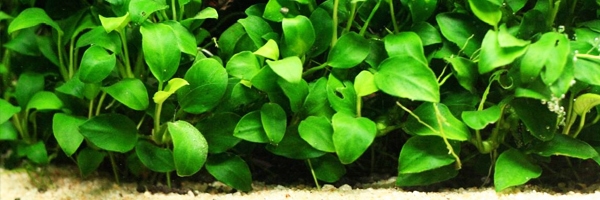
Check out this plant on Amazon!
| Some quick stats | |
| Growth Rate | Slow |
| Max Height | 16 inches |
| Lighting demands | Low |
| CO2 demands | Supplemental, Environmental |
| Difficulty | Easy |
Anubias is a robust flowering plant that may thrive in a range of tank setups. It’s simple to cultivate. This makes it an excellent choice for new hobbyists to plant aquariums. Most fish do not eat Anubias. However, some species, such as goldfish and cichlids, may try to pull it out. It grows slowly. However, if it is kept in a healthy environment, it will reward you with tiny white aquatic blossoms that resemble Peace Lilies. Anubias may blossom above or below the waterline, unlike many aquatic plants that send branches and flowers above the waterline. It requires little light and maybe supplemented with CO2.
Anubias is an underwater plant. However, it may be grown near the water’s edge. It is also a rhizomatic plant with root offshoots. Hence, it’s relatively simple to propagate. It may be placed on the substrate. It can also be allowed to float. However, it thrives if taught to stick to driftwood or pebbles. Anubias likes a somewhat acidic to moderate pH. It prefers temperatures between 72 and 82 degrees Fahrenheit.
| Pro’s | Con’s |
| Simple to grow | Slow-growing |
| Flowers in water | Grows well when attached to a surface |
| Simple to propagate | |
| Tough | |
| Optional supplementation | |
| Can grow in water or along the water line | |
| Will not be eaten by most fish |
2. Ludwigia Repens
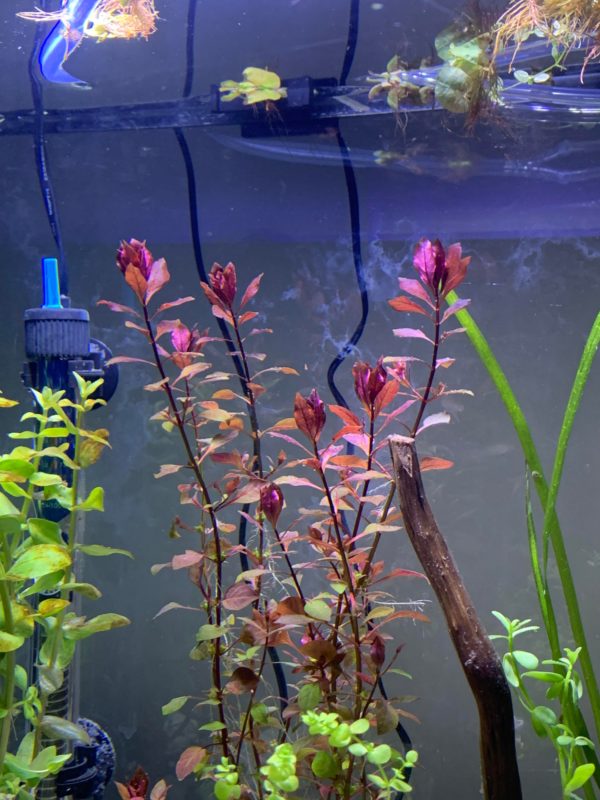
Check out this plant on Amazon!
| Some quick stats | |
| Growth Rate | Fast |
| Max Height | 20 inches |
| Lighting demands | Moderate to high |
| CO2 demands | Supplemental, Environmental |
| Difficulty | Easy |
Ludwigia Repens is a beautiful and low-maintenance complement to your aquarium. There is a green tint on top of the leaves with crimson undertones. Ludwigia Repens blossoms only if the branches rise above the waterline. However, even if your aquarium doesn’t permit development well above the waterline, the foliage is stunning either way. The blooms are tiny yet brilliant and milky golden in color. The seeds will fall into the substrate if the Ludwigia flowers are left to dry up and die. This will result in the formation of new plants.
These plants bloom fast. They are easy to replicate from seedlings and cuttings. They only need CO2 replenishment under optimal growth circumstances. If they are not maintained in check, it can lead to algae growth. This is because the plant needs moderate to high light for robust growth. Most fish prefer moving through the dense growth created by several Ludwigia Repens plants.
| Pro’s | Con’s |
| Simple to grow | Blooms only above the waterline |
| Grows quickly in water | Needs moderate to high lighting |
| Simple to propagate | Needs CO2 supplementation for the best growth |
| Tough | |
| Fish enjoys the protection provided by this plant | |
| Colorful leaves and flowers |
3. Hornwort
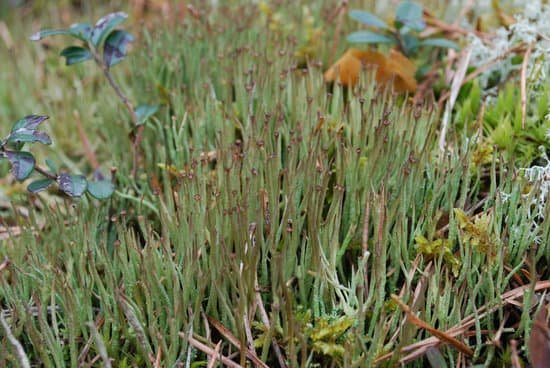
Check out this plant on Amazon!
| Some quick stats | |
| Growth Rate | Fast |
| Max Height | 10 feet |
| Lighting demands | Moderate |
| CO2 demands | Environmental |
| Difficulty | Easy |
Hornwort is indeed an excellent blooming plant for tanks. It is also effortless to maintain and grow. It is a perfect choice for your small fish that likes to hide in plants. This is because it grows tall and dense. Most fish would not eat it because of its rigid barbs. However, some will nibble and drop the barbs into the water. Hornwort contains tiny blooms which bloom just below the surface of the water. They are rosette-shaped and come in many colors of green. They are comparable to succulents.
Hornwort is a tough plant that thrives in a variety of situations, including low water quality. It also helps to enhance the aquarium by utilizing waste and toxins found in the tank to power its development. This is even one of the most significant aquarium oxygen providers. It withstands a temperature range of roughly 60-85 degrees Fahrenheit. It also likes a slightly acidic to neutral pH. You can plant it in the substrate or even leave it to float.
| Pro’s | Con’s |
| Grows Rapidly | Needs moderate lighting |
| Most fish will not eat it | Can leave off barbs in the water |
| Simple to grow | |
| Tough | |
| Improves water quality |
4. Bucephalandra
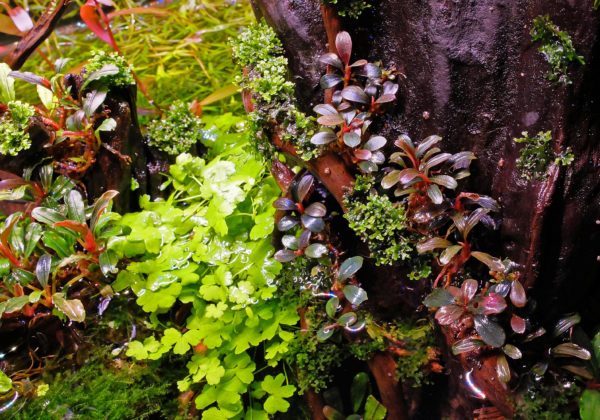
Check out this product on Amazon!
| Some quick stats | |
| Growth Rate | Slow |
| Max Height | 10 inches |
| Lighting demands | Low to high |
| CO2 demands | Environmental |
| Difficulty | Easy |
Several hobbyists are unfamiliar with Bucephalandra. However, it is increasing in popularity due to its toughness and lushness. The plant can grow entirely buried but also just above the waterline. It can also withstand harsh conditions. It usually produces white or pink blooms on stems just above the waterline. Bucephalandra may gain a foothold on a thin substrate such as sand. However, it thrives if taught to stick onto hard surfaces. Driftwood is an excellent choice. One can also use available materials like lava rock as a habitat. This will produce beneficial bacteria in the aquarium.
Bucephalandra grows at a snail’s pace. In intense light, it blooms the fastest. It will, however, grow nicely in dim lights over a period of time. It doesn’t really need the addition of CO2. Supplementation, on the other hand, may hasten its growth. However, it will remain to be slow. When the plant’s conditions change suddenly, it loses all or most of its leaves. But, they usually come back as and when the plant adapts to the new conditions.
| Pro’s | Con’s |
| Simple tp grow | Prolonged growth rate |
| Low lighting requirement | Blooms well on hard surfaces |
| Can grow without CO2 supplementation | |
| Tough | |
| Simple to propagate |
5. Amazon Sword
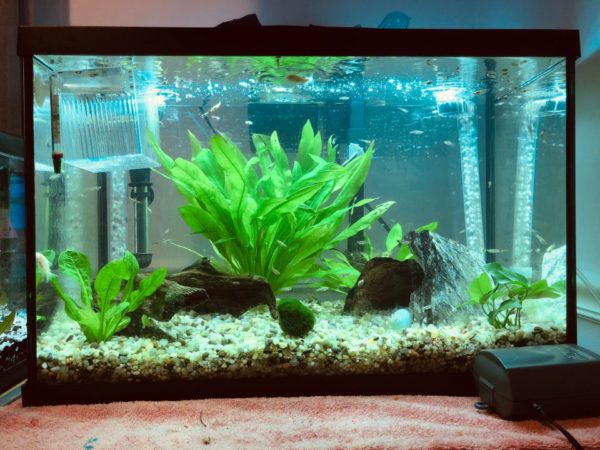
Check out this plant on Amazon!
| Some quick stats | |
| Growth Rate | Moderate |
| Max Height | 20 inches |
| Lighting demands | Moderate |
| CO2 demands | Environmental, Supplemental |
| Difficulty | Easy |
Amazon Swords are a very popular aquarium plant. With adequate treatment, it will blossom on a regular basis. White flowers occur on towering branches above the waterline on Amazon Swords. However, these flowers may also grow beneath the waterline too. Even though these plants are resilient, they require CO2 treatment. They also need a nutrient-rich substrate. They may develop to be quite tall. Hence, they provide excellent places to hide for fish who prefer hiding in their natural habitat.
Amazon Swords possess delicate foliage which is readily injured by fish such as Cichlids and Plecostomus. They thrive in communal aquariums with much more sensitive species like the Guppies. They tolerate warm temperatures as well as a pH range of mildly acidic to neutral.
| Pro’s | Con’s |
| Blooms throughout the year | Requires moderate lighting |
| Simple to grow | Requires nutrient-rich substrate |
| Can grow without CO2 supplementation | Needs warner water |
| Tough | |
| Great hiding spot for timid fish |
6. Giant Hygrophila
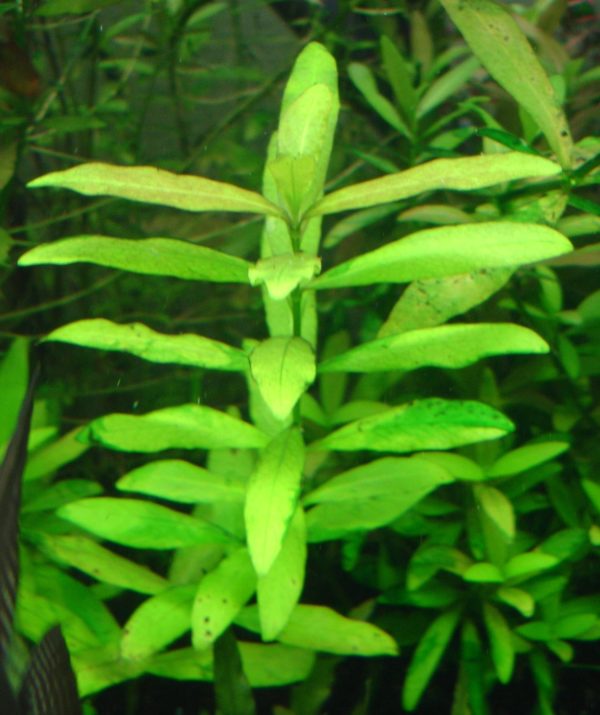
Check out this plant on Amazon!
| Some quick stats | |
| Growth Rate | Fast |
| Max Height | 20 inches |
| Lighting demands | Moderate to high |
| CO2 demands | Supplemental |
| Difficulty | Easy |
Giant Hygrophila is a large underwater or immersed plant which may thrive underneath the waterline. It develops swiftly if given a nourishing substrate, CO2 enrichment, and medium to high illumination. Giant Hygrophila foliage can be yellow in color. They even drop off under poor illumination and without supplements. Up or down the waterline, Giant Hygrophila will develop shoots with periwinkle blooms. The plant thrives in slow-moving water. This makes it an excellent choice for tanks.
Giant Hygrophila consumes pollutants within the water, just like the Hornwort. This helps in enhancing the quality of the water. In nature, it grows in tropical environments. Hence, it likes the temperature of the water to be over 75 degrees Fahrenheit. However, it may also thrive in colder temps. It can grow in pH ranges of 6.0 to 8.0. This makes it an excellent choice for tanks containing fish that can live in acidic, neutral, or primary water conditions. Because the foliage of Giant Hygrophila is delicate and quickly broken, it’s not really suitable for goldfish or cichlids.
| Pro’s | Con’s |
| Rapid growth rate | Needs moderate to high lighting |
| Simple to grow | Leaves are prone to damage |
| Improves water quality | Grows best with supplements |
| Can survive in varying pH levels | Needs warmer waters |
| Prefers mild water conditions |
7. Rotala Rotundifolia
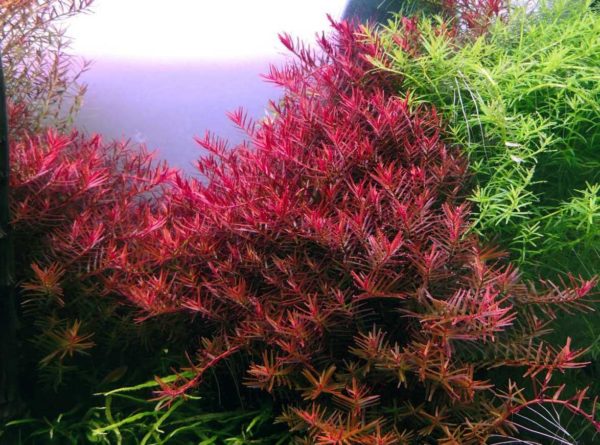
Check out this plant on Amazon!
| Some quick stats | |
| Growth Rate | Fast |
| Max Height | 12 inches |
| Lighting demands | Moderate |
| CO2 demands | Supplemental, Environmental |
| Difficulty | Easy |
The Rotala Rotundifolia is a very easy plant to take care of. Hence, they are an excellent option for novice aquarists. While not in flower, this plant comes in pink, red, and green variations. This gives the plant a vibrant alternative. It is also fragile. Hence, it cannot survive with a fish that attempts to dislodge it or eat its foliage. However, Guppies and Mollies will love the hideaways it provides. Rotala Rotundifolia is a fast-growing plant. It does not need CO2 replenishment in its habitat. However, it does benefit from it.
Rotala Rotundifolia can assume deeper colors of red or green in situations having lower concentrations of nutrients. Although, its development may be hindered. It loves medium illumination and will probably have to be trimmed regularly to stay in check. Plants of the Rotala Rotundifolia seldom breach the waterline. However, whenever they do, they sometimes generate several little lilacs or pinkish blooms piled on top of one another on the blooming stem.
| Pro’s | Con’s |
| Rapid growth rate | Infrequent flowering |
| Simple to grow | Needs routine trimming |
| Colorful stalks and leaves | Needs moderate lighting |
| Does not need CO2 supplementation | Has tender leaves and stalks |
| Gives hiding places for fish | |
| Generates multiple blooms | |
| Ideal for beginners |
8. Aquarium Banana Plant
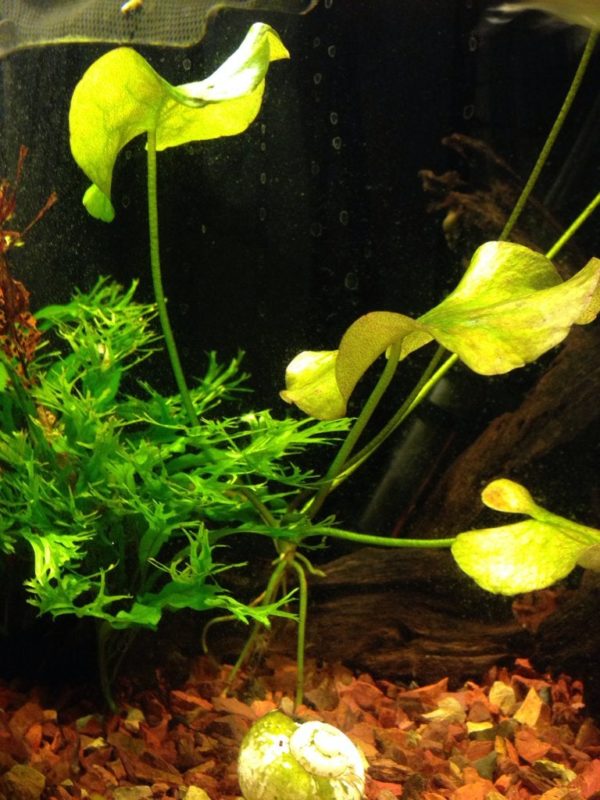
Check out this plant on Amazon!
| Some quick stats | |
| Growth Rate | Moderate |
| Max Height | 18 inches+ |
| Lighting demands | Low to high |
| CO2 demands | Environmental |
| Difficulty | Easy |
Aquarium Banana Plants aren’t actually banana plants. However, they get their title because of the banana-type roots at the plant’s bottom. These green roots are used to provide and house nutrients for the plant’s well-being. This plant may touch the waterline when the plant sends up stems. The plant produces little white blooms just above the waterline in ideal circumstances. Banana plants can be placed on the substrate. However, they can also anchor themselves in tanks with calm water conditions. They are hefty enough just to drop the majority of the time yet delicate enough just to hover above the substrate. This is where they will ultimately settle their roots.
It’s crucial to maintain the roots on top of the substrate if you’re planting the Banana plant on your own. This is done to avoid smothering the plant. Banana plants will not need CO2 supplements. However, the plant does demand a nutritionally rich substrate and water and the roots of such a plant are just a few inches in length. The plant’s stems may grow out to 18 inches in length. Because the plant can never heal broken foliage, it must be plucked out to minimize nutritional waste.
| Pro’s | Con’s |
| Unique appearance | Needs nutritional supplements |
| Simple to grow | Needs water with little to no currents |
| Can place itself in the substrate | |
| Does not need CO2 supplementation | |
| Height depends on the water conditions |
Why Do Plants Flower?
The primary purpose of flowering is reproduction. These newly formed flowers act as the reproductive organs of the flower. In the aquarium, most plants flower only above the waterline. Mostly, only their roots have been submerged into the water. This provides the plants with the chance to pollinate. A more common example of this would be lotuses and water lilies. The flowering of these plants may not always be colorful as the ones found outside the water. However, they will still flower. This is because flowering helps them create more of their own kind. Plants require the right conditions and optimal nutrients to be able to flower and reproduce themselves.
How long does it take for flowers to bloom?
Blooming differs from plant to plant. Some flowers bloom within days, and some even take weeks to bloom fully. This is because different plants have different ways of growing and blooming. On average, flowers take as little as 50 days to as long as 95 days to bloom fully.
Wrapping Up
After reading more about these eight plants, were you able to find the most beautiful plant for your tank? Aquarium plants help in enhancing the beauty of the aquarium. Apart from acting as a beauty enhances, these plants can also help your fish have a good time and feel safer. We hope that this guide has helped you understand the benefits of having aquarium plants.
